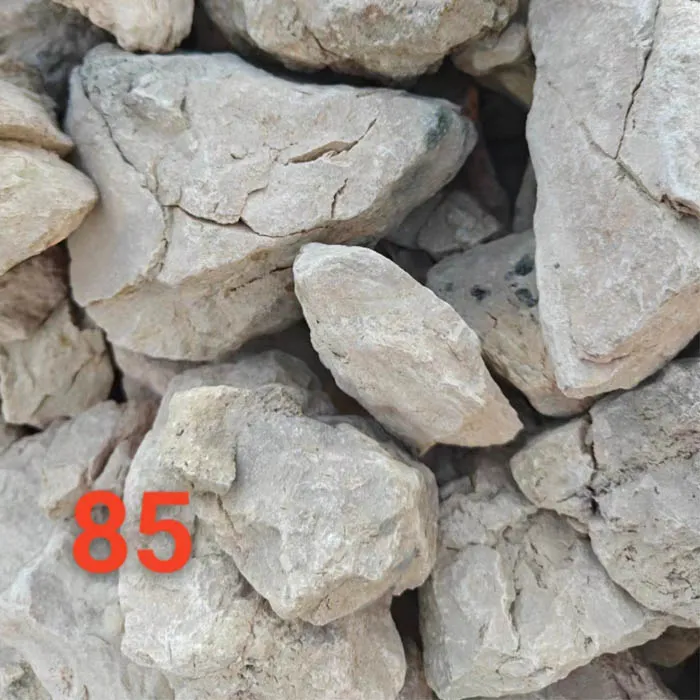5月 . 08, 2025 16:50 リストに戻る
Bauxite: The Essential Mineral Fueling the Future of Industrial Innovation
With increasing demand for raw materials that support modern infrastructure, construction, refractory, and aluminum production, ボーキサイト has emerged as a central figure in the global supply chain. Known for its versatility, color diversity, and critical mineral content, ボーキサイト continues to fuel industries ranging from metallurgy to abrasives. Whether shipped as bauxite in bulk for refineries or processed into high-grade calcined bauxite for refractory linings, its commercial and functional importance cannot be overstated.

Why Bauxite Appears White, Red, or Brown: The Science Behind Its Color
One of the most intriguing qualities of ボーキサイト is its varying color—ranging from white and gray to red and deep brown. This color is directly influenced by the mineral composition and impurities present in the deposit. When ボーキサイト appears white, it typically contains a higher proportion of aluminum hydroxide minerals like gibbsite and fewer iron oxides. These high-alumina, low-impurity grades are highly valued in chemical and metallurgical industries.
Conversely, the more iron-rich the ボーキサイト, the redder or browner its appearance. This is especially common in tropical regions where lateritic weathering dominates. For producers and buyers, understanding the coloration can signal ore quality, intended applications, and processing requirements. When purchasing bauxite in bulk, color grading is a key part of the quality assurance process that distinguishes high-value ore from lower-grade alternatives.
Bauxite vs. Calcined Bauxite: A Crucial Performance Distinction
Though ボーキサイト and calcined bauxite share the same base mineral, their industrial roles are vastly different due to the calcination process. Raw ボーキサイト contains moisture and volatile components, making it suitable for use in aluminum refining through the Bayer process. However, in applications requiring high thermal resistance and hardness—such as abrasives, refractories, and road surfacing—calcined bauxite is the material of choice.
Calcined bauxite is produced by heating ボーキサイト to temperatures above 1,000°C, eliminating volatile substances and significantly increasing its alumina content while enhancing its physical hardness. This transformation allows calcined bauxite to resist thermal shock, corrosion, and mechanical wear in high-stress industrial environments. Refractory bricks, high-friction surfaces, and kiln linings all depend on the unique properties of calcined bauxite.
The Rising Global Demand for Bauxite in Bulk
The global appetite for bauxite in bulk continues to surge, driven primarily by the booming aluminum sector. From automotive frames to beverage cans and aircraft parts, aluminum is one of the most used metals worldwide—and ボーキサイト is its only commercially viable ore. Rapid urbanization and increasing infrastructure investments in Asia, the Middle East, and Africa have elevated ボーキサイト to strategic mineral status.
Countries with large aluminum production capacities are stockpiling bauxite in bulk to secure long-term supply chains. The demand isn’t limited to aluminum alone. The growing refractory industry also relies heavily on calcined bauxite for furnace linings and blast furnaces. As such, manufacturers and trading companies are focusing on securing reliable sources of high-quality ボーキサイト, leading to increased exploration and international shipping volume.
Applications and Advantages of High-Quality Bauxite
The versatility of ボーキサイト extends into a wide range of industries, thanks to its unique chemical and physical properties. In addition to aluminum refining, ボーキサイト is used as an additive in cement, as a flux in steel manufacturing, and as a raw material for ceramics. These applications benefit particularly from high alumina content and low impurity levels, which make ボーキサイト ideal for processing without generating excessive waste.
When it comes to infrastructure development, road surfacing made with calcined bauxite offers superior skid resistance, making highways safer and more durable. Meanwhile, bauxite in bulk is also gaining traction in the production of proppants used in hydraulic fracturing for oil and gas extraction. These specialized uses underline ボーキサイト’s adaptability and continued relevance across modern industrial ecosystems.
Bauxite FAQs
What makes Bauxite appear white instead of red or brown?
White ボーキサイト typically contains lower levels of iron oxide and higher concentrations of aluminum hydroxide minerals, indicating a purer form of ore often used in specialty applications.
How is calcined bauxite different from raw Bauxite?
Calcined bauxite undergoes thermal processing to remove moisture and impurities, resulting in a denser, more durable material ideal for use in abrasives, refractories, and anti-skid road surfaces.
Why is Bauxite in bulk important for global industries?
Bauxite in bulk supports large-scale aluminum production, cement manufacturing, and refractory material supply, enabling consistent and efficient delivery to key industrial consumers worldwide.
Which industries use calcined bauxite the most?
Industries such as refractories, abrasives, road construction, and steel rely heavily on calcined bauxite due to its hardness, resistance to heat, and chemical stability.
What is driving the increase in global demand for Bauxite?
The rise in aluminum demand, infrastructure development, and the growth of the refractories market are primary factors increasing the global need for high-grade ボーキサイト and calcined bauxite.
-
Strength with Premium Steel and Calcined Bauxite
ニュースJul.28,2025
-
Revolutionize Construction Efficiency with Smart Industrial Materials
ニュースJul.28,2025
-
Redefined with High-Grade Iron Powder Solutions
ニュースJul.28,2025
-
Metallurgical Efficiency with Innovative Recarburisers and Covering Agents
ニュースJul.28,2025
-
Industrial Efficiency Enhanced with High-Performance Recarburizer Solutions
ニュースJul.28,2025
-
Boosted by Advanced Iron Powder and Carbon Additive Solutions
ニュースJul.28,2025
